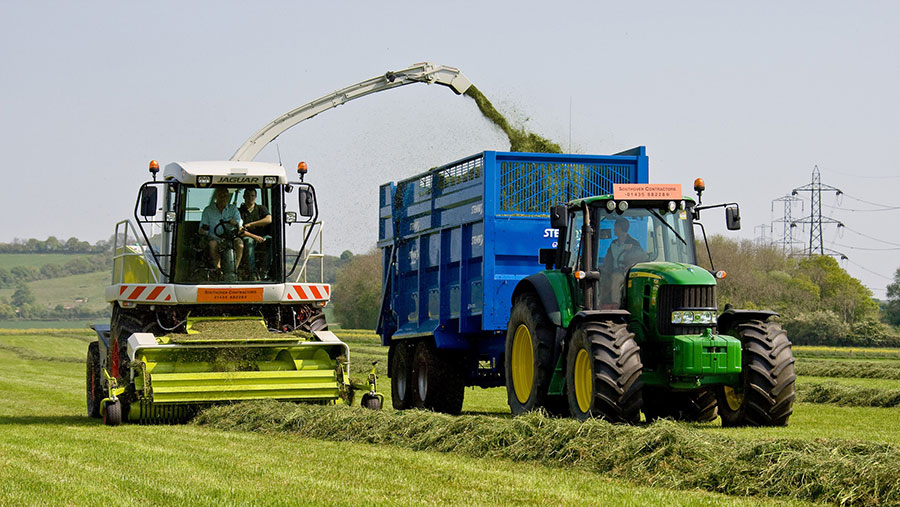4 tips to get timing of grass silage cutting right
 © Tim Scrivener
© Tim Scrivener If farmers are serious about increasing the production from forage, they need to minimise losses across the production process, starting with the crop in the field.
Timing of first cut is a crucial decision. Get it right and you will have better quality forage to drive production.
Liz Homer from Trouw Nutrition believes pre-cut sampling grass silage can help farmers improve the timing of first cut and produce a better-quality forage as a result.
Below she outlines how it can help improve ration quality and what to look for.
See also: How to decide if autumn block calving is right for you
1. Avoid cutting grass too late
When grass is at its optimum quality in the field before first cut it will have an energy content of about 12.8MJ/kg DM. Yet, when the clamps are opened, silage energy contents will be closer to 10.8MJ, representing a loss of about 16% of the available energy – although this varies from farm to farm.
In part, this will be due to factors at play during silage making, such as respiration losses while the crop is lying in the field and fermentation losses, but in many cases the biggest loss is a direct consequence of cutting grass too late (therefore quality in the field is lower), when it has gone beyond the optimum maturity.
As grass develops the ear stem, it goes through a process of increased lignification which reduces the digestibility of the whole plant and so leads to a decline in energy.
In simple terms, D value typically declines by about three units per week and this leads to a reduction of 0.5MJ in energy content, but the start date and the rate of decline may be faster or slower depending on the season.
2. Use pre-cut testing to guide when to cut
Pre-cut grass testing has been widely used to indicate how well it will ferment but it can also be used to indicate the optimum time to cut to maximise nutritive value.
Regular pre-cut analysis can tell a great deal about how the crop is developing and so allow timing of mowing to be more accurately assessed and planned.
3. When to sample
Sample at least two fields with different sward characteristics (one established ley and one new seed) by mid-April (although this will be farm dependent).
Start four weeks before the anticipated cutting date and sample weekly.
4. What to look for
Assess the results for the four key measures affecting fermentation and feed value.
Pre-cut analysis including neutral detergent fibre content will give a much more precise indication of when to cut grass to achieve the balance between silage quantity, quality and fermentation stability.
Pre-cut analysis |
||
|
Parameter |
Target |
Why is it important? |
|
Sugar |
Minimum 3% in freshweight (10% in DM)
|
Sugars are the fuel of fermentation. The higher the initial level the more efficient the fermentation and the higher the residual sugars giving a higher energy forage |
|
Free nitrates |
Less than 1,000mg/kg in freshweight
|
Free nitrates are where fertiliser nitrogen has not been converted into protein. They slow the rate of pH fall needed for a stable fermentation. |
|
NDF |
Below 40% DM |
A measure of fibre levels and an indication of plant maturity. Levels above 40% indicate grass is over mature and energy levels will be declining. Levels below 38% require very precise silage-making techniques. |
|
DM |
20% at mowing (Does this depend on factors such as ground conditions weather and wind?). |
Intakes are optimised with grass silage about 30-32%. At standard rates of drying in typical conditions grass cut at 20% will achieve this target with a 12-hour wilt, minimising respiration losses in the field. |
Grass growth variation
One of the problems is grass does not mature at the same rate every year. How it develops will be affected by the conditions over the preceding winter as well as the weather in the run up to first cut.
The graph above shows how neutral detergent fibre (NDF) content in pre-cut grass evolved in 2015, 2016 and 2017 and demonstrates the different pattern between the years.
- In 2015 NDF levels were higher from late April and rose gradually while in 2016 there was a rapid increase from the 8-22 May but from a much lower start point.
- Over this two week period, the rapid increase in NDF levels over the typical cutting dates in 2016 was enough to reduce grass ME content by 1.2MJ/kgDM, representing a huge cost of delayed cutting.
- 2017 however, was different again. The NDF levels remained low until the second half of May before accelerating away as grass matured later, meaning that harvest could have been taken anywhere from the 1-17 May with no detrimental impact on quality.
- However, as in the other years grass was about 42% NDF by the end of May by which time quality will be much lower.
- A single result in each of 2016 and 2017 would not show the different ways the crop was developing and the impact on cutting date.
- but by 15 May , one was still about 36% while the other was more than 42%.
Monitoring trends is therefore key if cutting dates are to be optimised.
